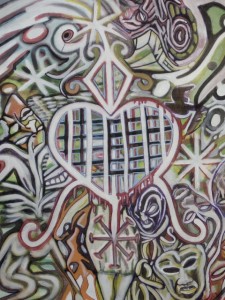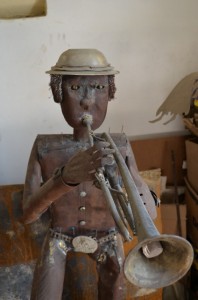As mentioned in the previous blog, most Haitians, even though they are Catholic, hold their voodoo-based beliefs right alongside, practicing and observing
![sm355[1]](https://blog.itscactus.com/wp-content/uploads/2012/12/sm35511-218x300.jpg)
Freda Veve, by Meda Ulyssee
Both the Veve and Cross represent points of transition. In the Catholic tradition, The Cross is the place where Jesus leaves the world of Man and enters into eternal life. Conversely, the Veve is the point at which the Loa spirits enter the world of Man. The drawing of a Veve in a Voodoo ceremony is an invitation for the spirits, one or more, to join the physical world and bestow health, strength, love, etc. to the supplicants in attendance. The Veves for each Loa vary, but all have a central cross figure included in their designs. If more

Another adaptation of the Erzulie Freda Veve, spotted in a Croix-des-Bouquets workshop
than one Loa is invited, the Veves connect at their trancepts.
In the beginning of any Voodoo ceremony, the Veve of Papa Legba is drawn. Papa Legba is regarded as the life giver, transferring the power of Bondye to the physical world and all who reside there. Papa Legba is
associated with St. Peter, holder of the keys to the gates of Heaven. In Voodoo, he is the gatekeeper of the spirit world where the Loa reside, and he must be invoked to bring any of the other Loa to the physical world. After his Veve is drawn (with sand, cornmeal, ground up eggshell or ash) other Loa Veves are drawn to invite them to the ceremony. With their arrival, their powers can be used by the priests, each according to the individual attributes of the Loa.
With the Veves in place, the ritual begins. Chanting, singing, drumming
and dancing beckon the Loa down from the cosmos.
Additionally, food, drinks, and gifts particularly pleasing to the individual Loa are placed on the Veve as offerings in exchange for service. At the end of the ceremony, when the Loa have

Music and dancing are important elements of any Voodoo ceremony
completed their earthly tasks, they are released with seven repetitions of the following benediction: “I thank you Loa for your services and let you go. Be blessed.” At that point, offerings which have been placed on the Veves are removed and the lovely, elaborate Veves are destroyed.
Though the form of The Cross and The Crossroads are essesntially the same, their symbolism dovetails, and their uses differ entirely within Catholic and Voodoo traditions. Yet by gaining an understanding of Voodoo and the history of it’s development in the New World, it is not impossible to see how both have come to be important, respected, and concerently revered – in Haiti and beyond.
Second in the series, “Voodoo Inspired”
Contributed By Linda of Beyond Borders/Its Cactus
